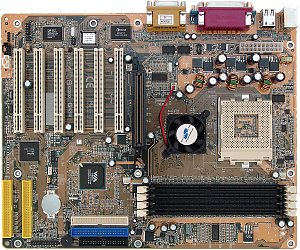Shuttle AK35GT2R (VIA KT333) Mainboard
|

The first impression you get when open the box is that this is a good
board. Without unnecessary pomp the company has released a new mainboard
on the PCB left from the VIA KT266A.
Accessories:
-
Package: standard design;
-
Documentation: user manual and a guide for IDE RAID - in English;
-
Cables: 2 ATA66/100/133 and FDD;
-
Bracket with two USB ports;
-
Bracket with a connector for AC components - Center/Sub;

-
CD with software including:
-
drivers;
-
user manual;
-
Adobe Acrobat Reader.

The layout is not the best: IDE RAID connectors are behind the PCI slots,
the audio-ins are in front of them, next to the edge of the board, and
the power connector is between the processor's socket and the rear panel.
It can be difficult to reach some jumpers when the board is already installed.
Their functions are shown on the textolite.
The 3-channel switching voltage regulator incorporates 8 capacitors
of 3300 uF.
The following controllers are integrated:
-
audio controller based on the C-Media CMI8738/PCI-6ch chip supporting 5.1
audio system and with a SPDIF-In/Out connector;
-
IDE RAID controller based on the HighPoint HPT372 chip, RAID 0, 1, 0+1
supported, ATA133 protocol.
Non-unsoldered connectors: connector for additional USB ports.
The system monitoring is supported by the Winbond W83697HF chip. What
is controlled:
-
processor and memory voltage, +3.3, +5 and +/-12 V, VBAT and +5 V Standby;
-
speed of 2 fans;
-
temperatures of the processor (a built-in sensor) and the board (a built-in
sensor).
There are 2 connectors for adjustable and 2 for unadjustable connection
of fans (a fan on the heatsink of the north bridge is connected to one
of them).
Brief characteristics of the board: memory slots - 4 DDR SDRAM;
expansion slots - AGP/ 6 PCI; I/O ports - 2 COM/ LPT/ 2 PS/2/ 4 USB 1.1;
dimensions - 305x245 mm.
Adjustment can be carried out with:
| jumpers and switches |
Jumper to clear up the CMOS |
|
| Jumper to prevent recording into Flash EEPROM |
|
| BIOS based on the 6.00PG version from Phoenix |
Setup of memory timings |
+ |
Cycle Length, Bank Interleave, Precharge to Active, Active to
Precharge, Active to CMD, Queue Depth, Command Rate |
| Setup of memory frequency |
+ |
By SPD, 100, 133 and 166 MHz |
| Setup of AGP bus |
+ |
|
| Setup of PCI bus |
+ |
|
| Changeable scaler of AGP and PCI buses |
- |
|
| Manual assignment of interrupts |
+ |
|
| Changeable FSB frequency |
+ |
100-200 MHz in 1MHz steps |
| Changeable CPU multiplier |
+ |
x5.5-x14 |
| Changeable core voltage |
+ |
1.1-1.85 V in 0.025V steps |
| Changeable memory voltage |
+ |
Default, 2.55, 2.6 and 2.7V steps |
| Changeable chipset voltage |
- |
|
| Changeable AGP bus voltage |
- |
|
We used the latest available version of the BIOS - AK35S20C.
The board doesn't sport anything interesting, even the set of accessories
looks quite pale; though it still has all the necessary functions with
some pleasant bonuses. Besides, this model showed a brilliant speed,
that is why, coupled with a low price, this board will probably be popular
with users.
Test results:
Write a comment below. No registration needed!
|
|
 |
|
|
|



